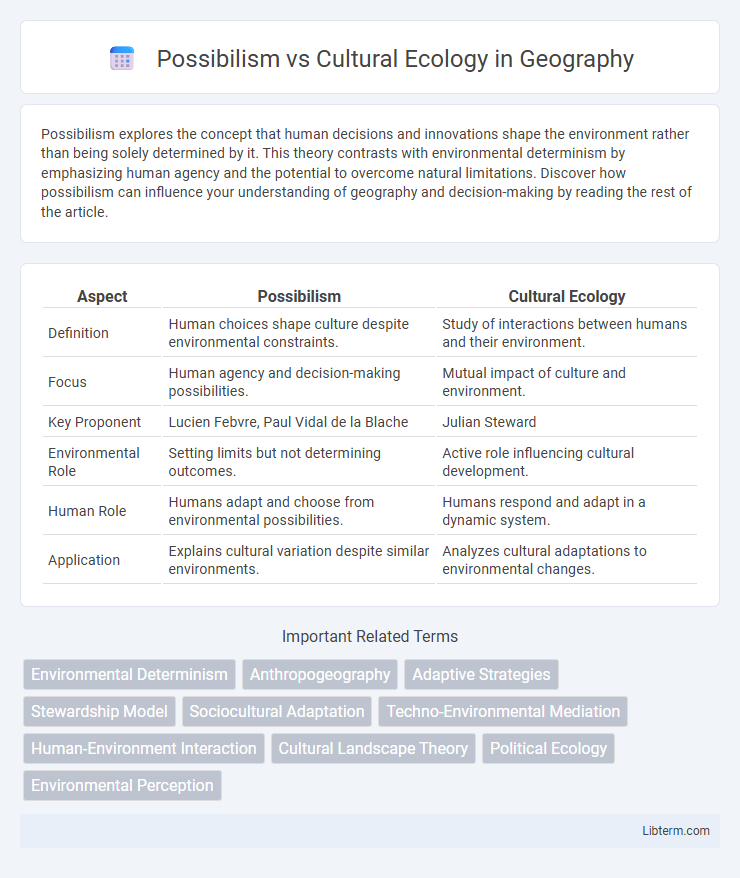Possibilism explores the concept that human decisions and innovations shape the environment rather than being solely determined by it. This theory contrasts with environmental determinism by emphasizing human agency and the potential to overcome natural limitations. Discover how possibilism can influence your understanding of geography and decision-making by reading the rest of the article.
Table of Comparison
| Aspect | Possibilism | Cultural Ecology |
|---|---|---|
| Definition | Human choices shape culture despite environmental constraints. | Study of interactions between humans and their environment. |
| Focus | Human agency and decision-making possibilities. | Mutual impact of culture and environment. |
| Key Proponent | Lucien Febvre, Paul Vidal de la Blache | Julian Steward |
| Environmental Role | Setting limits but not determining outcomes. | Active role influencing cultural development. |
| Human Role | Humans adapt and choose from environmental possibilities. | Humans respond and adapt in a dynamic system. |
| Application | Explains cultural variation despite similar environments. | Analyzes cultural adaptations to environmental changes. |
Introduction to Possibilism and Cultural Ecology
Possibilism in geography emphasizes human agency and decision-making in shaping cultural landscapes despite environmental constraints, highlighting the range of choices societies have in adapting to their surroundings. Cultural ecology examines the interactions between humans and their environment, investigating how cultural practices develop in response to ecological conditions and environmental challenges. Both frameworks address the dynamic relationship between culture and environment, with possibilism focusing on human creativity and cultural ecology on adaptive environmental interactions.
Historical Background and Development
Possibilism emerged in the early 20th century as a response to environmental determinism, emphasizing human agency in shaping cultural landscapes despite environmental constraints. Cultural ecology was developed in the mid-20th century by anthropologist Julian Steward, focusing on the dynamic interactions between human societies and their environments through adaptive strategies. Both frameworks significantly influenced geographic and anthropological studies by highlighting the balance between environmental factors and cultural innovation.
Key Theorists and Contributors
Possibilism, championed by geographer Paul Vidal de la Blache, argues human agency shapes cultural landscapes despite environmental constraints. Cultural Ecology, advanced by Julian Steward, emphasizes the relationship between culture and environment through adaptive strategies. Both theories contribute fundamentally to understanding human-environment interactions in geographic studies.
Core Principles of Possibilism
Possibilism centers on the idea that while the environment sets certain constraints, human agency and innovation primarily shape cultural development and societal changes. It emphasizes the capacity of humans to choose different pathways within environmental limits, highlighting adaptation, technological progress, and decision-making as core principles. Unlike Cultural Ecology, which stresses the environment's influence on cultural practices, Possibilism asserts that societies actively shape their destinies through strategic adaptations.
Fundamental Concepts in Cultural Ecology
Cultural ecology emphasizes the dynamic interaction between human societies and their environments, highlighting how cultural practices adapt to ecological constraints to ensure survival and resource management. It considers the environment as a limiting factor, but cultural choices and innovations shape the degree of adaptation, reflecting a reciprocal relationship between nature and culture. Fundamental concepts include the analysis of subsistence strategies, environmental adaptation, and the feedback loop between ecological systems and social organization.
Human-Environment Interaction: Comparative Analysis
Possibilism emphasizes human agency in modifying the environment, suggesting that while natural conditions impose constraints, humans adapt and innovate to shape their surroundings according to cultural preferences. Cultural ecology examines the dynamic interactions between human societies and their environments, analyzing how cultural practices evolve to manage ecological challenges and resource availability. Comparative analysis reveals that possibilism highlights human creativity and choices in environmental adaptation, whereas cultural ecology integrates ecological processes and cultural traits to explain the complex feedback loops in human-environment systems.
Criticisms and Limitations of Each Approach
Possibilism faces criticism for underestimating environmental constraints by overemphasizing human agency in shaping cultural development, often neglecting how physical geography limits possibilities. Cultural ecology is limited by its tendency to reduce complex social relations to environmental determinism, sometimes ignoring historical and economic factors influencing cultural adaptations. Both approaches struggle to fully integrate interdisciplinary perspectives, which limits their ability to comprehensively explain the dynamic interactions between humans and their environments.
Case Studies Illustrating Each Theory
Case studies illustrating possibilism include the Nile River Valley, where ancient Egyptians adapted agriculture to the river's annual floods, demonstrating human agency in modifying environmental conditions. Cultural ecology is exemplified by the Inuit of the Arctic, whose subsistence strategies and social organization are directly shaped by the harsh polar environment, highlighting the environment's role in cultural development. These cases underscore possibilism's emphasis on human choice versus cultural ecology's focus on environmental determinism within human-environment interactions.
Contemporary Relevance in Geography
Possibilism and Cultural Ecology remain crucial frameworks in contemporary geography for understanding human-environment interactions. Possibilism emphasizes human agency in adapting to environmental constraints, highlighting the role of technology and innovation in shaping landscapes. Cultural Ecology focuses on the dynamic relationship between cultural practices and natural ecosystems, informing sustainable development and environmental management strategies in diverse regions.
Conclusion: Synthesizing Possibilism and Cultural Ecology
Possibilism emphasizes human agency and decision-making within environmental constraints, while cultural ecology highlights the interaction between cultural practices and ecological systems. Synthesizing both approaches provides a comprehensive understanding of how societies adapt to and modify their environments through cultural innovations and technological advances. This integration facilitates resilient strategies for sustainable development by acknowledging environmental limits alongside human creativity and cultural diversity.
Possibilism Infographic

 libterm.com
libterm.com